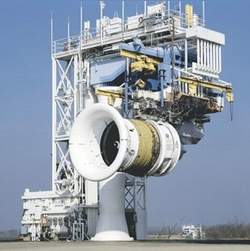Mon, Aug 26, 2013
Company Also Evaluating Design Improvements Drive High Aerodynamic Performance
Testing is underway on new composite fan blades for the GE9X, the next-generation GE90 engine that will power Boeing’s 777X aircraft. This validation test is the first of several testing programs GE has planned this year for the GE9X fan module. The first round of fan blade tests occurred in June at the ITP Engine testing facility in the United Kingdom and focused on validating the new composite material for the fan blades. The results were very positive. GE plans a second round of tests at ITP later this summer to further validate the new fan blade composite material and a new metal material for the fan blade leading edge.

This fall, GE plans to run Universal Propulsion Simulator (UPS) fan performance tests on a fan rig at a Boeing facility in Seattle, Washington. Work is already under way on the fan rig and facility for these tests. “The GE9X fan blade will feature new high-strength carbon fiber material and a steel alloy leading edge,” said Bill Millhaem, general manager of the GE90 Program at GE Aviation. “This new material, along with a higher fan tip speed, will improve the efficiency of the low-pressure turbine (LPT) and deliver more than 1.5 percent fuel efficiency improvement compared to the GE90-115B engine.”
The GE9X fan module incorporates several unique features. The GE9X front fan will be the largest of any GE engine at 132 inches in diameter and include a durable, lightweight composite fan case similar to the fan case on the GEnx. Compared to a metal fan case, the composite fan case will lower the weight by 350 lbs. per engine.
The fan blades in the GE9X engine will be fourth-generation composite fan blades. GE Aviation developed the first composite fan blade for its GE90-94B engine in 1995. Composite fan blades are also featured in the GE90-115B and GEnx engines. GE has accumulated 36 million flight-hours with composite blades and anticipates accumulating more than 100 million flight-hours when the GE9X enters service later this decade.

The GE9X engine will have 16 fan blades, which is fewer blades than the GEnx and the GE90-115B engines. This fan blade reduction is possible as a result of advancements in three-dimensional (3D) swept design that enables engineers to create a more swept design and large fan chord. The new high-strength carbon fiber material allows the blades to be thinner than blades made from current carbon fiber material, with the same strength and durability. These improvements will drive fuel efficiency improvements and hundreds of pounds of weight reduction from fan blades and the structure needed to support them.
The lower blade count and new carbon fiber composite material will enable GE Aviation to increase the fan tip speed. The increased tip speed will improve the efficiency of the LPT, enabling a reduction in the LPT blade count and contributing to the engine’s fuel burn improvement.
GE says the GE9X engine for Boeing’s 777X aircraft will be in the 100,000 pounds thrust class with a 10 percent improvement in fuel burn over today's GE90-115B. Key features include: a 132" fan diameter; composite fan case and fourth-generation composite fan blades; next-generation 27:1 pressure ratio high-pressure compressor; a third-generation TAPS (twin annular pre-swirl) combustor for greater efficiency and low emissions; and ceramic matrix composite (CMC) material in the combustor and turbine.
GE Aviation has been conducting tests on new materials and technologies for the engine during the last few years. Along with fan blade tests at the ITP Engine testing facility in the United Kingdom, GE Aviation will test a high-pressure compressor rig at GE’s Oil & Gas facility in Massa, Italy, this month. The first engine will test in 2016, with flight-testing on GE’s flying testbed anticipated in 2017. Engine certification is scheduled for 2018.
(GE90 engine on test stand pictured in file photo)
More News
The Industry Continues to be Rocked By Some Questionable Operations Recent investigations and a great deal of data has resulted in ANN’s SportPlane Resource Guide’s rep>[...]
Make Sure You NEVER Miss A New Story From Aero-News Network Do you ever feel like you never see posts from a certain person or page on Facebook or Instagram? Here’s how you c>[...]
Visual Approach Slope Indicator (VASI) An airport lighting facility providing vertical visual approach slope guidance to aircraft during approach to landing by radiating a directio>[...]
Airport Marking Aids Markings used on runway and taxiway surfaces to identify a specific runway, a runway threshold, a centerline, a hold line, etc. A runway should be marked in ac>[...]
Aero Linx: The Skyhawk Association The Skyhawk Association is a non-profit organization founded by former Skyhawk Pilots which is open to anyone with an affinity for the A-4 Skyhaw>[...]
 Unfortunate... ANN/SportPlane Resource Guide Adds To Cautionary Advisories
Unfortunate... ANN/SportPlane Resource Guide Adds To Cautionary Advisories ANN FAQ: Turn On Post Notifications
ANN FAQ: Turn On Post Notifications ANN's Daily Aero-Term (04.29.24): Visual Approach Slope Indicator (VASI)
ANN's Daily Aero-Term (04.29.24): Visual Approach Slope Indicator (VASI) ANN's Daily Aero-Term (04.28.24): Airport Marking Aids
ANN's Daily Aero-Term (04.28.24): Airport Marking Aids ANN's Daily Aero-Linx (04.28.24)
ANN's Daily Aero-Linx (04.28.24)




